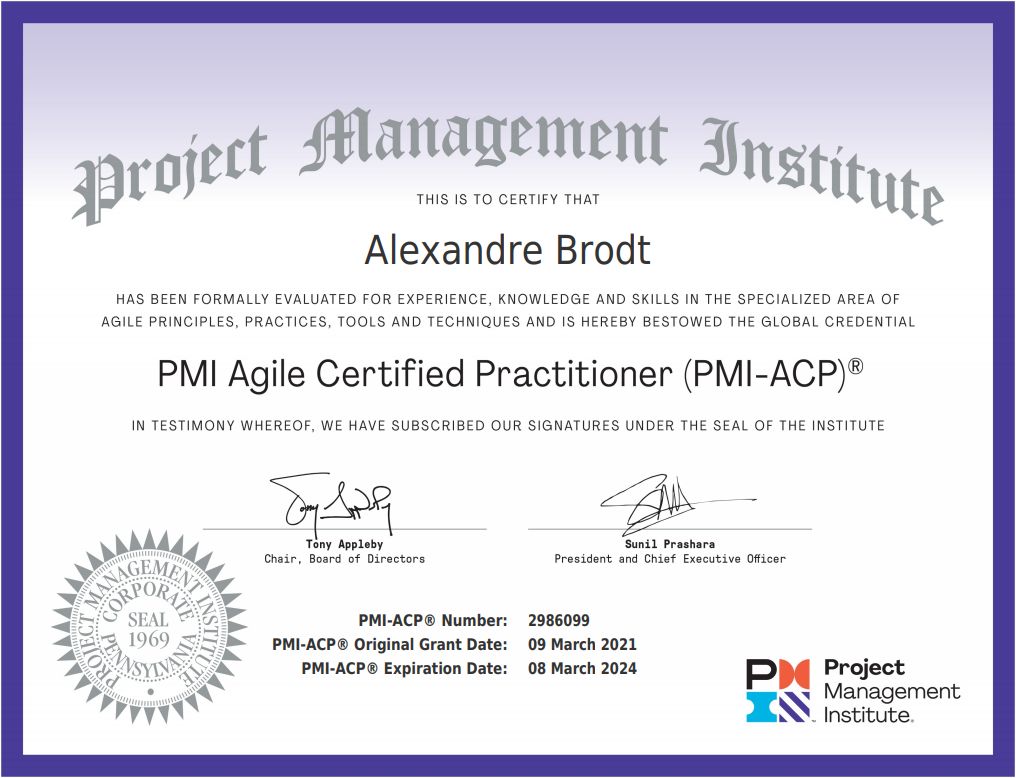PMI-ACP® certification: my experience and how I prepared
- 9 de março de 2021

This achievement has a special taste. After a good period studying and applying in daily work, I conquered the PMI-ACP certification. I always wanted to face this exam because it doesn’t stick to a single method, tests agility foundation applied in real scenarios and moves through Lean, XP, Kanban, Crystal and Scrum in a practical way. It’s an assessment full of situational questions, focused on what you would do now to deliver value, improve flow and reduce risk.
I leave my thanks to my wife and daughter, who accepted the odd hours and tight routine, and to Vitor Massari, whose book and course were decisive in the final stretch. Gratitude also to Compass.uol for constant encouragement.

For those eyeing the exam, it’s worth aligning some expectations. The scope is broad and the board expects decisions anchored in transparency, inspection and adaptation. When I took it, in March 2021, there were 120 questions in three hours, with some pilot items, all on computer. Eligibility asked for proven experience in projects and formal agile training, so it’s good to check current requirements directly with PMI. The response pattern privileges value delivery, short feedback, stakeholder collaboration and continuous improvement, and discourages excessive control, bureaucracy and choices without data.
Domains appear with similar frequency, but I felt more weight in agile principles and mindset, value driven delivery, stakeholder engagement, team performance, adaptive planning, problem detection and resolution and continuous improvement in product, process and people. In language of those on the gemba, prioritize by value, use flow metrics like WIP, lead time and cycle time, read CFD regularly, conduct good risk conversations and maintain feedback cadence.
My preparation, like in other certifications, was lean and organized as a project. I defined a target date, set up a short daily routine and focused on essentials. I studied PMI’s Agile Practice Guide with Agile Alliance, revisited Scrum Guide and Kanban Guide, reread Lean principles and noted XP practices like TDD, refactoring, pair and continuous integration. Vitor’s course and book helped consolidate situational reading. I did quality simulators and, when reviewing, explained aloud the reason for the correct alternative. I created flashcards with domains, cadences, flow metrics and anti-patterns, and closed with a light mind map that gathered concepts like DoD, DoR, relative estimation, agile contracts and risk burndown.
If I had to suggest a four-week roadmap, I’d put the first for agile mindset, Manifesto, principles and Lean focusing on waste elimination. The second for Scrum and XP, roles, events, artifacts, DoD and DoR, plus technical practices. The third for Kanban and flow, explicit policies, WIP limits, lead and cycle time reading and Cumulative Flow Diagram interpretation, along with greater care with stakeholder engagement. The fourth for adaptive planning, incremental releases, relative estimation, agile risk and light governance, adding two or three complete simulators and an error-guided review. You can shorten the schedule if review is quality and understanding-based.
At exam time, always choose the alternative that maximizes value now with lowest risk, support your decisions on flow data and user feedback, promote collaboration over rigid contracts, prefer short cycles with transparency and adaptation and avoid command and control and heavy documentation that doesn’t add value. The materials that helped me most were the Agile Practice Guide, Scrum and Kanban guides, Vitor’s course and book, plus my maps and flashcards. A good simulator serves to measure consistency and time.
After the result, work continues. Certification validates the foundation, but what transforms is practicing with purpose. Take learning to the team, measure, adjust and keep improving. If I can help in any way on this journey, count on me.
Now let’s go to the next challenges, 2021 is just beginning!! Shall we go together? How can I help you?